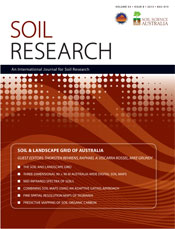
Soil Research
Volume 53 Number 8 2015
Soil & Landscape Grid of Australia
SR15191Soil and Landscape Grid of Australia
SR14366The Australian three-dimensional soil grid: Australia’s contribution to the GlobalSoilMap project
The GlobalSoilMap project aims to produce a grid of soil attributes at a fine spatial resolution and at six depths. This paper describes the three-dimensional spatial modelling used to produce the Australian soil grid, which consists of Australia-wide soil attribute maps. The modelling combines historical soil data plus estimates derived from visible and infrared soil spectra. The Australian three-dimensional soil maps are envisaged to fill a significant gap in the availability of quantitative soil information.
SR14270Large-area spatial disaggregation of a mosaic of conventional soil maps: evaluation over Western Australia
We spatially disaggregated conventional soil maps across Western Australia. The resulting soil class rasters display the expected patterns of dominant soils, reconciling their distributions across most survey boundaries. Map validation revealed the disaggregated maps still retain features related to the mapping intensity of the original surveys; profiles collected during soil survey may be biased towards rare soils, making them less suitable for validation or modelling directly from point data.
SR14274Derivation of soil-attribute estimations from legacy soil maps
It is increasingly necessary to extract even more information from legacy soil maps. We mapped clay content and its uncertainty for Western Australia and the agricultural region of South Australia at six depth intervals using digital soil-class maps that were derived from legacy soil-map information. The results demonstrate harmonisation of soil data from several sources into a map with a common specification and highlight areas where our soil knowledge is incomplete.
SR14271Derivation of terrain covariates for digital soil mapping in Australia
Digital soil mapping relies on a range of relevant layers called covariates that are used to predict soil types and properties. Terrain covariates capture properties of the land surface that are relevant to soil prediction, such as slope and topographic position. A suite of relevant and commonly used terrain covariates has been developed for all of Australia to support consistent soil mapping across the continent.
SR14275Combining two soil property rasters using an adaptive gating approach
We propose a new method to combine models called adaptive gating, which is inspired by the use of gating functions in mixture of experts, a machine learning approach to forming hierarchical classiffiers. We compare it here with two standard approaches – inverse-variance weights and a regression based approach. Further application of adaptive gating demonstrating its value in other areas of science will bolster the case for pursing such computational research.
SR15019How does grinding affect the mid-infrared spectra of soil and their multivariate calibrations to texture and organic carbon?
We report on the effect that grinding to different particle sizes have on soil mid-IR spectra. Our aims were to compare the effect of grinding soil to different particle sizes on the frequencies of mid-IR spectra, and compare the effect of these particle sizes on the accuracy of spectroscopic calibrations to predict organic carbon, sand, silt and clay contents. Generally, better predictions for clay, sand and soil organic carbon contents were achieved using soil that is more finely ground. Grinding did not affect predictions of silt content. Recommendations on how much grinding is needed should also consider the time, cost and effort needed and the purpose of the analysis.
SR15171Developing the Australian mid-infrared spectroscopic database using data from the Australian Soil Resource Information System
SR14268Eighty-metre resolution 3D soil-attribute maps for Tasmania, Australia
Digital Soil Mapping was used to map a range of soil attributes at different depths across Tasmania, Australia, using existing soil site data and explanatory spatial variables, and producing associated uncertainties of predictions. The maps contributed to and followed the ‘Soil and Landscape Grid of Australia’ specifications, and form the first version of a spatial soil resource for Tasmania that will be updated and improved through future soil sampling.
SR15100Predictive mapping of soil organic carbon stocks in South Australia’s agricultural zone
Better understanding the spatial distribution of soil organic carbon (SOC) is important for managing soil resources and informing potential responses to climate change. We applied contemporary digital soil mapping (DSM) techniques to develop a predictive map of SOC stocks in the top 30 cm, and their uncertainty, across South Australia’s agricultural zone. We demonstrate the value of combining legacy and contemporary datasets, expert soil knowledge and modern statistical analysis tools, and we discuss practical considerations for operationalising DSM.



